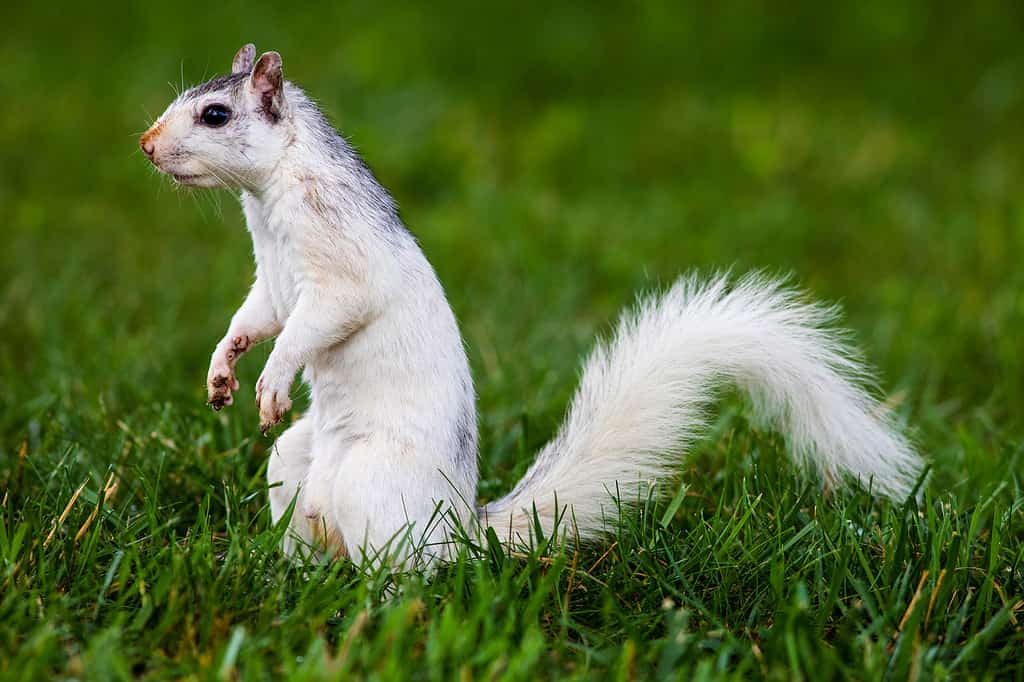Orlando, FL, is home to the one-of-a-kind theme park Gatorland. Gatorland is now home to a one-of-a-kind white alligator. There are fewer than nine known leucistic alligators in the world. There are, however, several albino alligators who look similar—but not the same as—Gatorland’s 20-inch, quarter-pound hatchling. In this article, we’ll look at the differences between albinism and leucism. We’ll also take a closer look at this hale beauty in the Sunshine State and explore just how rare a white alligator really is.
Small Surviving Sample Size for Paler Creatures

An albino alligator resting on a rock. These white animals are vulnerable to predators as their white skin makes it difficult to camouflage themselves in their habitat.
©one5zero/Shutterstock.com
The news of this white offspring is remarkable because she’s a leucistic alligator. Leucism means an organism has less pigmentation than most members of their species. Albinism is the absence of all pigmentation.
Answering the question just how rare a white alligator really is means figuring out how many leucistic and albino alligators there are; no easy task.
The most challenging part for any albino or leucistic animal is that their stark appearance can make them an easy target for predators. As such, many become prey early in life meaning a smaller sample size to be observed in the wild. (Perhaps it helps in certain parts of the permanent arctic.)
One taxonomy with some data is birds. The live birth of avians with leucism or albinism is about 1 in 30,000.
Particulars of Albinism and Leucism for Alligators
Being reptiles, albino and leucistic alligators have yet another challenge. Reptiles need external heat, being cold-blooded animals. Alligators with translucent skin face the likelihood of sunburn in Sunshine State. Given the numerous survival risks for these critters, they might be more common than we know; we just don’t see them enough. Gatorlands current white alligators have a special, partially-shaded enclosure.
White Alligators By the Numbers
- News reports have varied as to how many documented living leucistic alligators exist; some say there are eight, and some reports say seven
- There are at least a dozen zoos or universities in the US with one or more albino alligators
- Both leucistic and albino alligators are quite rare, though leucistic ones look to be the rarer of the two
- There are around 5 million gators (Alligator mississippiensis) in the US, meaning this lucky female hatchling in Gatorland might be literally more rare than one in a million
Telling the Difference, More Details on Albinism and Leucism

Leucistic, albino and piebald animals (like this
squirrel
) have a stark appearance that generally makes them even easier prey than the predatory alligator.
©Sasha Craig/Shutterstock.com
Albino creatures will have red or pink eyes. Leucistic alligators still have pigmentation in the eyes. Some organisms with leucism may also have patches of pigmented hyde or fur within an overall white or cream-colored exterior. A third and indeterminate category is “piebald,” wherein an animal will have noticeable patches of both pale and pigmented exterior.
Studies on Lizards Might Shed Light on Reptile Leucism

Studying leucism in other reptiles such as lizards is yielding new insights.
©Heather Shimmin/Shutterstock.com
The Herpetological Bulletin published a study in 2016 on related reptiles—in this case, Roatán Spiny-tailed Iguanas (Ctenosaura oedirhina). These creatures are found on an island in Guatemala, and the study noted how certain specimens were born with a “piebald” or partial leucistic appearance while others actually showed an “ontogenetic shift” and changed appearance and amounts of leucism after birth. They also noted a correlation between leucism and snout size.
The Cajun Pedigree of Gatorland’s Newest Sensation
The healthy female baby gator hatched alongside her normal colored brother and she, indeed, has dark blue eyes. Interestingly, the recessive gene of leucism did not affect their mother. Only the Dad has a pale appearance.
A nest of white gators was discovered back in the 1980s in Louisiana. Several offspring from that clutch took up residence at Gatorland.
The two newcomers to Gatorland are medically cleared getting a clean bill of health from the vet.
Other Reports of White Alligators
In the 2000s and 2010s, some reports surfaced of white alligators in the wilds of South Carolina. Thomas Rainwater, a coastal ecology professor at Clemson University published on the findings in Southeastern Naturalist in 2020. Poachers snarled up their safety, indicating just how rare a white alligator really is. Though none survived long into adulthood, a few were rescued from poachers.
A press release from the university touted the creatures as the first known photographs of leucistic alligators in the wild.
The White Alligator in Florida is Under Lock and Key, and Looking for a Name
Management at Gatorland has bulked up their security to keep this as-yet-unnamed gatorette safe. A white alligator could easily be a target for black market collectors. Her birth was actually concealed for several months.
As of this publishing, Gatorland is seeking the public’s help to brainstorm a name for this rare beauty.
Thank you for reading! Have some feedback for us? Contact the AZ Animals editorial team.








